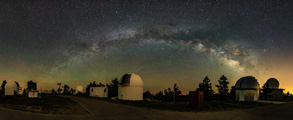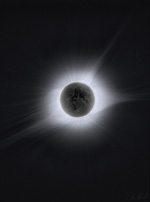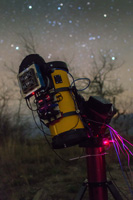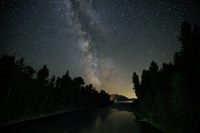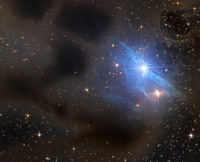Spotlight

Congratulations to three of our Graduate Students
Three of our graduate students were recognized yesterday for their Excellence in Service, Teaching, and Scholarship.
Recognized in a College of Science Award ceremony yesterday were:
- Eckhart Spalding - Service Award, Department of Astronomy
- Melissa Halford - Teaching Award, Department of Astronomy
- Carolyn Raithel - Scholarship Award, Department of Astronomy and, as announced yesterday, named Outstanding Scholar for the entire College of Science!
Congratulations to them and to those who support our outstanding students!

Gurtina Besla Honored for TIMESTEP
The Office of Diversity and Inclusive Excellence and the Commission on the Status of Women are honoring several people, including Astronomy/Steward's Assistant Professor Dr Gurtina Besla. Besla is receiving the Edith Sayre Auslander Emerging Vision Award for her work with the TIMESTEP program. You can read about the award and about TIMESTEP HERE and HERE.

New Giant Magellan Video
"Great Big Story" has made a three minute video of Dr Pat McCarthy at the Richard F. Caris Mirror Lab. You can find it HERE.
Pat is a member of a long line of distinguished University of Arizona undergrads (BS, Physics, 1983). He is a staff member at Carnegie Observatories in Pasadena, and Vice President for Operations and External Relations at the GMT. You can find out more information about GMT at their website.

20 Years of Studying the HR 4796A Debris Ring
Twenty years ago, the Hubble Space Telescope (HST) turned its then recently installed Near InfraRed Camera and Multi-Object Spectrometer (NICMOS; an instrument designed and built under the direction of UA astronomers with Prof. R. Thompson as PI) on a 240 light-year distant, young (about 8 million years old) star known as HR 4796A. UA astronomer Glenn Schneider, using the instrument's coronagraphic camera (designed to reduce the glare of the star itself), then discovered a solar-system size bright ring of starlight-scattering debris particles surrounding the star, whose existence was suspected from prior measured thermal radiation. At the time, HR 4796A became only the second such starlight-scattering circumstellar debris disk imaged (Beta Pic is the first, as well as our own Sun's zodiacal light). The disk was thus understood as a tracer for planetary system formation and evolutionary processes in play. Since then, about 40 other such starlight-scattering debris systems have been coronagraphically imaged, but they - with HR 4796A being one of the best studied - have closely hoarded many of their secrets hidden still in the remaining blinding light of their host stars.
Now, after two decades of intense scrutiny with the most advanced telescopes and instruments on Earth and in space, Dr. Schneider and his collaborators have revisited the HR 4796A system with a visible-light coronagraph in NICMOS's sister instrument, STIS (Space Telescope Imaging Spectrograph), to produce the most deeply sensitive images of its circumstellar environment - with some unexpected surprises. The prior seen debris ring itself was revealed to be deeply embedded within a much larger, and very faint, starlight-scattering "halo" of inferred small particles extending from HR 4796A as far as 875 Earth-Sun distances (AU). These particles are likely created within the ring by planetesimal collisions, thus replenishing the environment, and blown outward by the star's own radiation pressure and/or the debris system's interaction with the local interstellar medium. The latter is betrayed in the new images by an enhancement in the brightness of the dust on the leading edge of the exoplanetary debris system, indicative of a bow shock as the system plows its way through interstellar space. The debris halo, additionally, is extremely asymmetric and appears truncated in the direction toward its much fainter red-dwarf companion, HR 4796B at about 580 AU, whose presence may also be influencing the distribution of the dust particles. You can see these features in the photo which can be enlarged HERE. Details of this investigation appear in a new paper in the February, 2018 Astronomical Journal (Schneider et al., AJ, 155, 77). Other coauthors with Steward connections are Andras Gaspar and Dean Hines.
The Space Telescope Science Institute press release can be found HERE.
(we thank Dr Glenn Schneider for providing the text.)

Understanding the Spiral Structure in HD100453A's Protoplanetary Disk
In a new paper Kevin Wagner et al. report on the disk structure and evolution in a spiral protoplanetary disk hosting binary. (Steward astronomers on this paper are Wagner, Ruobing Dong, Patrick Sheehan, Dániel Apai, Katie Morzinski, Laird Close, Jared Males, and Phil Hinz.)This disk represents one of only a few “grand-design” (two-armed) spiral protoplanetary disks, the only one in which a low-mass companion has also been detected. Wagner et al. present the first constraints on the companion’s orbit, utilizing data from VLT/NACO, VLT/SPHERE, and Magellan/MagAO. They also constrain the disk inclination from ALMA observations and gas kinematic modeling: the companion’s orbital semi-major axis (105±15 au) is 3-4 times greater than the observed extent of the disk; the companion orbits in the same plane of the disk to within measurable limits (±10º) on a low eccentricity orbit (e<0.3), in accordance with a classical disk truncation scenario. Utilizing these constraints on the system geometry in combined hydrodynamic and radiative transfer simulations, they find in all cases that the companion generates a prominent two-armed spiral pattern in the simulated disk imaging that is in good agreement with the observed spiral disk structure. This system represents a benchmark in understanding the formation of spiral arms in protoplanetary disks, and has implications for on-going planet searches in the other similar disks that do not host binary companions, but nevertheless host similar spiral features. The figure (with an enlarged version in the linked press release) shows observations on the left and the model on the right.
A summary of this paper (ApJ, 854, 130 (2018) can be found on AAS NOVA and on Astrobites.
(Thanks to Kevin Wagner for text.)
Pages

For Public
Public events include our Monday Night Lecture Series, world-reknowned Astronomy Camp and Mt Lemmon Sky Center.

For Students
A good place to start if you want to become an undergrad major or grad student, or need to find our schedule of classes.

For Scientists
Find telescopes and instruments, telescope time applications, staff and mountain contacts, and faculty and staff scientific interests.




